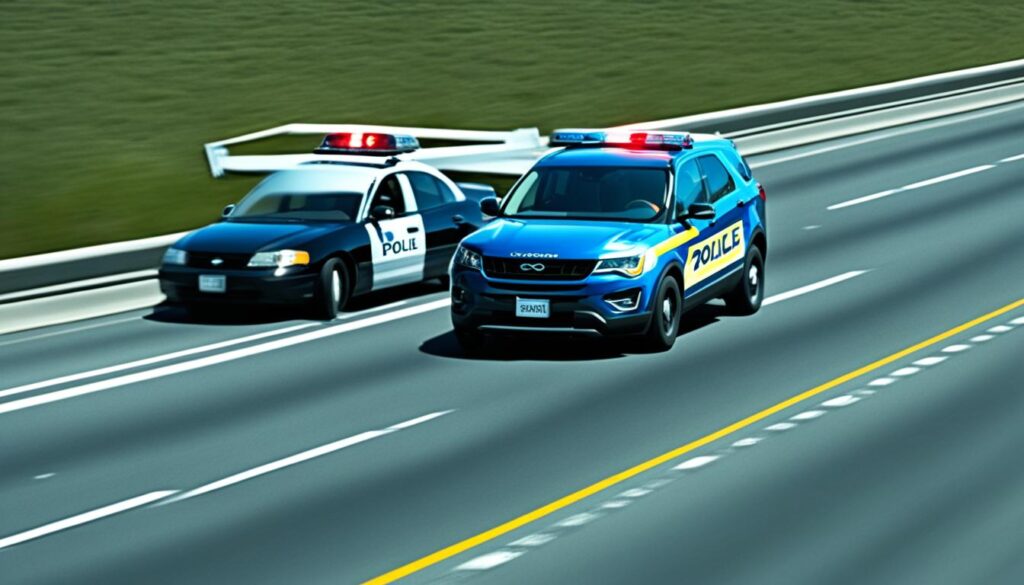When driving on the highway, encountering a broken centre line can often leave drivers wondering if they can legally overtake the truck in front of them. Understanding highway rules, road safety, and traffic regulations is key to making the right decision in such situations. Let’s delve into the details to ensure you have a clear understanding of when and how to pass on the highway while adhering to the lane restrictions.
Key Takeaways:
- Continuous centre lines indicate no overtaking or U-turns.
- Single continuous centre lines can be crossed to enter or leave a road.
- Broken centre lines allow for legal overtaking on the highway.
- Overtaking across broken centre lines is permitted, even when turning or doing U-turns.
- It’s essential to be aware of different road line markings and their corresponding rules for safe driving.
Understanding Road Markings in Queensland
In Queensland, road markings are essential for guiding drivers on the road and ensuring safe and legal driving practices. These markings consist of various types of lines that serve specific purposes and have distinct rules and regulations associated with them. By understanding these road markings, drivers can navigate the roads with confidence and contribute to a safer driving environment.
Continuous Centre Lines
The continuous centre lines are solid lines that separate traffic moving in opposite directions. These lines indicate that overtaking or crossing them is not allowed, except for specific circumstances. It is important to respect these markings to avoid potential collisions and ensure the safety of all road users.
Broken Centre Lines
Broken centre lines, on the other hand, indicate that drivers may overtake if it is safe to do so. These broken lines are typically seen on roads with multiple lanes in each direction. However, it is crucial to exercise caution and assess the surrounding conditions before attempting to overtake another vehicle.
Lane Lines and Edge Lines
Lane lines are used to separate individual lanes of traffic, guiding drivers and helping to maintain proper lane discipline. Edge lines, on the other hand, mark the outer edges of the roadway. It is important to stay within the designated lane and not cross the edge lines unless necessary, such as when avoiding an obstruction or when merging.
Stop and Give Way Lines
Stop and give way lines are used to indicate where drivers should come to a complete stop or yield to other vehicles or pedestrians. These lines are typically seen at intersections and require drivers to adhere to the specific rules associated with them. Respecting these lines is crucial for ensuring the smooth and safe flow of traffic.
Wide Centre Lines
Wide centre lines are often found in rural areas and provide additional space between opposing lanes of traffic. These lines help improve safety by reducing the risk of head-on collisions. Drivers should be mindful of these markings and maintain their position within the designated lane to ensure safe and efficient traffic flow.
Understanding the various road markings in Queensland is essential for all drivers. By following these markings and adhering to the rules and regulations associated with them, drivers can contribute to a safer road environment. Whether it’s respecting the continuous centre lines, using appropriate lanes, or yielding at stop and give way lines, each driver plays a vital role in maintaining road safety. Let’s all do our part and drive responsibly for the well-being of everyone on the road.
Crossing Continuous Centre Lines
When driving on the highway, it’s important to understand the rules regarding continuous centre lines. Continuous centre lines are there to guide and manage traffic flow, and it’s crucial to follow them to ensure a safe driving experience.
Entering or Leaving a Road: A single continuous centre line can be crossed when entering or leaving a road. This means that if you need to turn off the highway or access a nearby road, you can safely cross the single continuous centre line.
Passing Bicycle Riders: Another instance where you can cross a single continuous centre line is when passing bicycle riders. As a driver, it’s essential to provide a safe distance and overtaking opportunity for cyclists on the road. Crossing the continuous centre line to give them enough space is permitted and promotes road safety.
Remember, always check for oncoming traffic before crossing the continuous centre line and ensure it is safe to do so.
However, it’s important to note that double continuous centre lines should never be crossed unless you are safely passing a bicycle rider. Double continuous centre lines indicate that overtaking or crossing is strictly prohibited, even if you’re trying to access another road or make a turn.
Safety should always be the top priority while driving on the highway. By understanding and adhering to the rules surrounding continuous centre lines, you can ensure a smooth and secure journey for yourself and other road users.
Overtaking Across Broken Centre Lines
When it comes to overtaking on the highway, broken centre lines play a crucial role. These markings indicate that overtaking is permitted in certain situations. If you encounter a broken single centre line or a broken centre line to the left of a continuous centre line, you have the legal freedom to overtake the vehicle ahead of you.
In addition to overtaking, these broken centre lines also allow for making turns or performing U-turns. They provide drivers with the flexibility to navigate their way through traffic and reach their destinations efficiently.
However, it’s important to mention that double broken centre lines are treated the same as single broken centre lines. So, if you come across a road with double broken centre lines, the same overtaking and turning rules apply.
By understanding and adhering to the rules surrounding broken centre lines, you can safely utilize these markings to navigate the highway and reach your destination with ease.
The Key Points:
- Overtaking is allowed across broken centre lines on the highway.
- If you see a broken single centre line or a broken centre line to the left of a continuous centre line, you can overtake a vehicle.
- These broken centre lines also permit making turns and performing U-turns.
- Double broken centre lines have the same legal standing as a single broken centre line.
By understanding and following these rules, you’ll be able to make safe and legal use of broken centre lines for overtaking, turning, and U-turns, ensuring a smooth and efficient journey on the highway.
Guidelines for Overtaking on Multi-Lane Roads
Overtaking on multi-lane roads requires following specific guidelines to ensure safe and efficient traffic flow. While the general rule is to overtake on the right side of the road, there are exceptions that allow for left-side overtaking under certain circumstances.
Right-Side Overtaking:
Right-side overtaking is the standard approach on multi-lane roads. This means overtaking another vehicle by moving to the right lane and passing it on the driver’s side. This practice allows for clear visibility and minimizes the risk of collisions.
Left-Side Overtaking:
Left-side overtaking is permissible in specific situations:
- If it can be safely done
- If directed by an authorized person
- If the vehicle in the right lane is stationary or moving at a significantly lower speed
- If the vehicle in front is indicating a right turn or U-turn
When deciding to overtake on the left side, it is crucial to assess the surrounding conditions and ensure that it can be done safely without compromising road safety.
“The goal of overtaking on multi-lane roads is to maintain smooth traffic flow and minimize congestion. Drivers should exercise caution and consider the safety of themselves and other road users when deciding whether to overtake on the left side.”
Benefits of Right-Side Overtaking
Right-side overtaking on multi-lane roads offers several advantages:
- Clear visibility of the road ahead and oncoming traffic
- Reduced risk of collisions due to the driver’s side being less obstructed
- Alignment with standard driving practices and expectations
By following this guideline, drivers can ensure a safer and more efficient overtaking process on multi-lane roads.
Overtaking Laws Across Australia
Overtaking laws play a crucial role in ensuring road safety and consistent rules for drivers across Australia. While there may be slight variations in the laws from state to state, the fundamental principles remain the same. It is essential for all drivers, especially those traveling interstate, to familiarize themselves with these laws to avoid penalties and potential risks on the road.
Key Overtaking Laws to Be Aware Of
When it comes to overtaking on Australian roads, there are several important guidelines to keep in mind:
- Clear visibility: Before attempting an overtaking maneuver, ensure that you have a clear line of sight of the road ahead, especially in terms of approaching traffic.
- Sufficient space: Always ensure that there is enough room to safely overtake another vehicle without impeding the flow of traffic or compromising road safety.
- Legal speed limit: Adhere to the designated speed limit while overtaking. Speeding violations can lead to penalties and increased risks on the road.
Interstate Travel and Consistency
For drivers traveling across state borders, it is crucial to note the variations in overtaking laws. While certain state-specific rules may differ, the overarching goal of ensuring road safety and consistent regulations remains the same. Take the time to familiarize yourself with the specific laws of each state or territory you plan to visit. This will help you avoid any unwanted penalties and promote a smoother and safer journey.
| State | Overtaking Laws |
|---|---|
| New South Wales | Consistent with national overtaking laws, New South Wales enforces safe overtaking practices, emphasizing clear visibility, sufficient space, and adherence to the legal speed limit. |
| Victoria | Victoria follows similar overtaking laws as other states, focusing on clear visibility, maintaining a safe distance, and obeying the speed limit. |
| Queensland | Queensland’s overtaking laws align with national regulations, emphasizing safe overtaking practices and adherence to road safety guidelines. |
| Western Australia | Western Australia enforces consistent overtaking laws designed to ensure road safety, including clear visibility, sufficient space, and compliance with speed limits. |
| Tasmania | Tasmania adopts the national overtaking laws, focusing on clear visibility, sufficient space, and adherence to the legal speed limit to ensure road safety. |
Road Safety and Penalties
Road safety is paramount when it comes to overtaking, and failure to adhere to the rules can result in penalties. Penalties vary depending on the specific offense committed and the state or territory in which it occurs. It is important to understand the potential consequences of breaching overtaking laws to ensure compliance on the road. Taking the necessary precautions can save lives and prevent accidents.
Remember, safe overtaking contributes to a smoother and more efficient flow of traffic, while prioritizing the well-being of all road users. Familiarizing yourself with the overtaking laws in your state or territory is crucial to promote a safer road environment for everyone.

Overtaking Cyclists and Minimum Passing Distance
When it comes to overtaking cyclists on the road, ensuring their safety is of utmost importance. Australia has specific regulations regarding minimum passing distance, aimed at protecting cyclists and promoting road safety.
According to these regulations, drivers are required to maintain a minimum passing distance while overtaking cyclists. This distance is set at 1 meter for roads with a speed limit of 60km/hr or less, and 1.5 meters for roads with a speed limit greater than 60km/hr. It is crucial to adhere to these guidelines to prevent accidents and ensure the well-being of cyclists.
By providing sufficient space between the vehicle and the cyclist, drivers can minimize the risk of collisions and create a safer environment for everyone on the road. This minimum passing distance allows cyclists to maintain their balance and stability, reducing the chances of accidents caused by close proximity or sudden maneuvers.
| Speed Limit | Minimum Passing Distance |
|---|---|
| 60km/hr or less | 1 meter |
| Greater than 60km/hr | 1.5 meters |
The enforcement of minimum passing distance regulations underscores the commitment to road safety in Australia. It is essential for drivers to be aware of and respect these guidelines to protect vulnerable road users, such as cyclists. By maintaining a safe distance during overtaking maneuvers, drivers contribute to a harmonious and secure road environment.
Benefits of Minimum Passing Distance Regulations
Implementing and adhering to minimum passing distance regulations offers several benefits:
- Enhances cyclist safety on the road
- Reduces the risk of accidents and collisions
- Promotes mutual respect and understanding between drivers and cyclists
- Fosters a sense of responsibility and consideration in all road users
- Encourages the growth of cycling as a safe and viable transportation option
By recognizing the importance of minimum passing distance and following the prescribed regulations, drivers can actively contribute to safer roads and demonstrate their commitment to road safety.
Penalties for Overtaking Offenses
Overtaking offenses can result in penalties and demerit points, which vary depending on the state or territory. It is important to be aware of the specific penalties in your jurisdiction to avoid legal consequences.
When it comes to overtaking, there are certain actions that can lead to penalties and demerit points on your driving record. Some common overtaking offenses include:
- Overtaking at an unsafe distance: This refers to overtaking another vehicle without leaving enough space between your vehicle and the one being overtaken. This can be dangerous and can result in penalties and demerit points.
- Overtaking on a continuous white line: Overtaking on a continuous white line is illegal in most jurisdictions. It is important to wait for a suitable opportunity to overtake safely and legally.
- Exceeding the speed limit while overtaking: Speeding laws still apply when overtaking another vehicle. It is important to ensure that you are not exceeding the speed limit while performing an overtaking maneuver.
The penalties for these offenses can vary, but generally, you can expect fines and demerit points. The specific penalties will depend on the state or territory in which the offense occurred. It is essential to familiarize yourself with the laws and regulations in your jurisdiction to avoid any legal consequences.
Here is an overview of the potential penalties for overtaking offenses in different states:
| State/Territory | Penalties | Demerit Points |
|---|---|---|
| New South Wales | Fine of up to $2,200 | 2-5 |
| Victoria | Fine of up to $399 | 3 |
| Queensland | Fine of up to $2,928 | 4 |
| Western Australia | Fine of up to $400 | 4 |
| South Australia | Fine of up to $2,500 | 3 |
| Tasmania | Fine of up to $600 | 3 |
| Australian Capital Territory | Fine of up to $2,500 | 4 |
| Northern Territory | Fine of up to $1,500 | 3 |
These penalties are subject to change, so it is always best to check the latest information from your local traffic authority.
Remember, the consequences of overtaking offenses go beyond just fines and demerit points. Unsafe overtaking can lead to accidents and compromised road safety. It is crucial to prioritize the safety of yourself and others on the road by adhering to overtaking rules and regulations.

Importance of Road Line Markings for Safety
Road line markings play a crucial role in ensuring road safety and preventing traffic violations. These markings, found throughout Queensland, provide important visual cues for drivers, guiding them on the road and promoting safe driving practices.
Understanding the different types of road line markings is essential for safe driving. Continuous centre lines, for example, indicate that drivers cannot cross them to overtake or perform a U-turn. On the other hand, broken centre lines allow for overtaking and turning. Lane lines help drivers stay within their designated lanes, while edge lines signal the outer boundaries of the road.
By following these road line markings and adhering to the regulations associated with them, drivers can contribute to a safer road environment. These markings enhance the flow of traffic, reduce the risk of accidents, and minimize traffic violations.
“Road line markings provide essential guidance for drivers and play a vital role in maintaining road safety. They help ensure that drivers stay in their lanes, know when it is safe to overtake, and understand the boundaries of the road. Adhering to these markings is not only a legal requirement but also a responsible action that contributes to the overall safety of the road.”
By following road line markings, drivers can reduce the risk of accidents, prevent traffic violations, and ensure a smooth and efficient flow of traffic. It is important for all drivers in Queensland to be aware of and respect these markings to create a safer road environment for everyone.
Conclusion
Understanding the rules and regulations surrounding overtaking on highways, including the use of broken centre lines and adherence to road line markings, is crucial for legal and safe driving. By following these guidelines, drivers can ensure the safety of themselves, other road users, and cyclists. It is important to always prioritize road safety and be aware of the specific rules in the state or territory you are traveling in.
Legal overtaking on highways relies on a clear understanding of the highway rules and regulations. Paying attention to road line markings, such as broken centre lines, can help drivers determine when it is safe to overtake. However, it is important to remember that road safety should always be the top priority.
By familiarizing yourself with the highway rules and regulations, you can contribute to a safer road environment. Whether it’s understanding when and where overtaking is allowed or following the speed limits and passing distances, each driver plays a crucial role in ensuring road safety. So, always stay informed, be considerate towards other road users, and make responsible decisions on the road.
